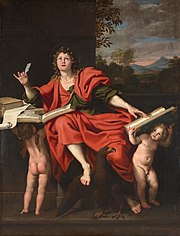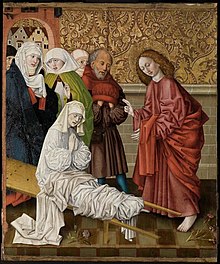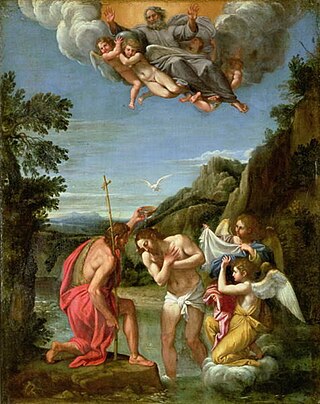
Adoptionism, also called dynamic monarchianism, is an early Christian nontrinitarian theological doctrine, subsequently revived in various forms, which holds that Jesus was adopted as the Son of God at his baptism, his resurrection, or his ascension. How common adoptionist views were among early Christians is debated, but it appears to have been most popular in the first, second, and third centuries. Some scholars see adoptionism as the belief of the earliest followers of Jesus, based on the epistles of Paul and other early literature. However, adoptionist views sharply declined in prominence in the fourth and fifth centuries, as Church leaders condemned it as a heresy.
Gospel originally meant the Christian message, but in the 2nd century it came to be used also for the books in which the message was reported. In this sense a gospel can be defined as a loose-knit, episodic narrative of the words and deeds of Jesus, culminating in his trial and death and concluding with various reports of his post-resurrection appearances. Modern biblical scholars are cautious of relying on the gospels uncritically, but nevertheless, they provide a good idea of the public career of Jesus, and critical study can attempt to distinguish the original ideas of Jesus from those of the later Christian authors.
The New Testament (NT) is the second division of the Christian biblical canon. It discusses the teachings and person of Jesus, as well as events in first-century Christianity. The New Testament's background, the first division of the Christian Bible, is called the Old Testament, which is based primarily upon the Hebrew Bible; together they are regarded as sacred scripture by Christians.

John the Apostle or Saint John the Beloved was one of the Twelve Apostles of Jesus according to the New Testament. Generally listed as the youngest apostle, he was the son of Zebedee and Salome. His brother James was another of the Twelve Apostles. The Church Fathers identify him as John the Evangelist, John of Patmos, John the Elder, and the Beloved Disciple, and testify that he outlived the remaining apostles and was the only one to die of natural causes, although modern scholars are divided on the veracity of these claims.

The Gospel of Thomas is an extra-canonical sayings gospel. It was discovered near Nag Hammadi, Egypt, in December 1945 among a group of books known as the Nag Hammadi library. Scholars speculate that the works were buried in response to a letter from Bishop Athanasius declaring a strict canon of Christian scripture. Scholars have proposed dates of composition as early as 60 AD and as late as 250 AD. Since its discovery, many scholars have seen it as evidence in support of the existence of a "Q source" which might have been very similar in its form as a collection of sayings of Jesus without any accounts of his deeds or his life and death, referred to as a sayings gospel.

Marcion of Sinope was an early Christian theologian in early Christianity. Marcion preached that God had sent Jesus Christ who was an entirely new, alien god, distinct from the "vengeful" God who had created the world. He considered himself a follower of Paul the Apostle, whom he believed to have been the only true apostle of Jesus Christ; his doctrine is called Marcionism. Marcion published the earliest record of a canon of New Testament books.
Marcionism was an early Christian dualistic belief system that originated with the teachings of Marcion of Sinope in Rome around the year 144. Marcion was an early Christian theologian, evangelist, and an important figure in early Christianity. He was the son of a bishop of Sinope in Pontus. About the middle of the 2nd century (140–155) he traveled to Rome, where he joined the Syrian Gnostic Cerdo.

The New Testament apocrypha are a number of writings by early Christians that give accounts of Jesus and his teachings, the nature of God, or the teachings of his apostles and of their lives. Some of these writings were cited as scripture by early Christians, but since the fifth century a widespread consensus has emerged limiting the New Testament to the 27 books of the modern canon. Roman Catholic, Eastern Orthodox, and Protestant churches generally do not view the New Testament apocrypha as part of the Bible.
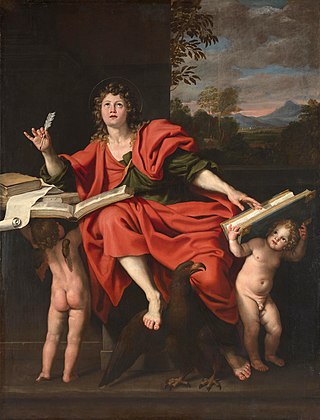
The authorship of the Johannine works has been debated by biblical scholars since at least the 2nd century AD. The debate focuses mainly on the identity of the author(s), as well as the date and location of authorship of these writings.
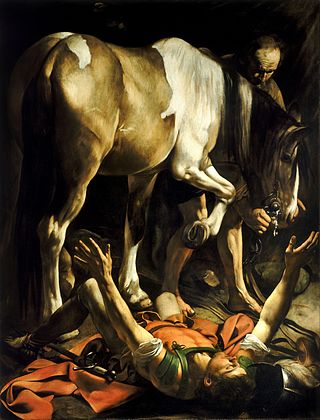
The Pauline epistles are the thirteen books in the New Testament traditionally attributed to Paul the Apostle.

The Gospel of Mary is a non-canonical text discovered in 1896 in a fifth-century papyrus codex written in Sahidic Coptic. This Berlin Codex was purchased in Cairo by German diplomat Carl Reinhardt.

The Acts of Paul and Thecla is an apocryphal story–Edgar J. Goodspeed called it a "religious romance"–of Paul the Apostle's influence on a young virgin named Thecla. It is one of the writings of the New Testament apocrypha.
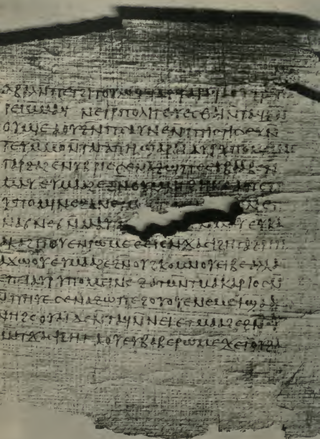
The Epistle of the Apostles is a work of New Testament apocrypha. Despite its name, it is more a gospel or an apocalypse than an epistle. The work takes the form of an open letter purportedly from the remaining eleven apostles describing key events of the life of Jesus, followed by a dialogue between the resurrected Jesus and the apostles where Jesus reveals apocalyptic secrets of reality and the future. It is 51 chapters long. The epistle was likely written in the 2nd century CE in Koine Greek, but was lost for many centuries. A partial Coptic language manuscript was discovered in 1895, a more complete Ethiopic language manuscript was published in 1913, and a full Coptic-Ethiopic-German edition was published in 1919.
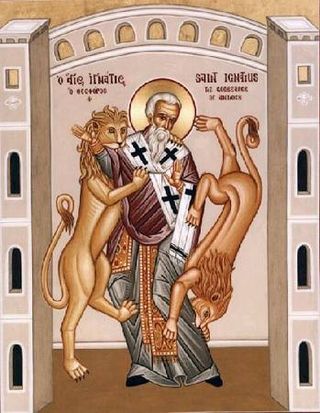
The term proto-orthodox Christianity or proto-orthodoxy describes the early Christian movement that was the precursor of Christian orthodoxy. It was coined by Bentley Layton, but is often erroneously attributed to New Testament scholar Bart D. Ehrman. Ehrman argues that this group from the moment it became prominent by the end of the third century, "stifled its opposition, it claimed that its views had always been the majority position and that its rivals were, and always had been, 'heretics', who willfully 'chose' to reject the 'true belief'." In contrast, Larry W. Hurtado argues that proto-orthodox Christianity is rooted in first-century Christianity.

The Acts of the Apostles is a genre of early Christian literature, recounting the lives and works of the apostles of Jesus. The Acts are important for many reasons, one of them being the concept of apostolic succession. They also provide insight into the valuation of "missionary activities among the exotic races," since some of them feature missionary work done among, for instance, the Cynocephaly.

Christianity in the 1st century covers the formative history of Christianity from the start of the ministry of Jesus to the death of the last of the Twelve Apostles and is thus also known as the Apostolic Age. Early Christianity developed out of the eschatological ministry of Jesus. Subsequent to Jesus' death, his earliest followers formed an apocalyptic messianic Jewish sect during the late Second Temple period of the 1st century. Initially believing that Jesus' resurrection was the start of the end time, their beliefs soon changed in the expected Second Coming of Jesus and the start of God's Kingdom at a later point in time.

Traditionally in Christianity, orthodoxy and heresy have been viewed in relation to the "orthodoxy" as an authentic lineage of tradition. Other forms of Christianity were viewed as deviant streams of thought and therefore "heterodox", or heretical. This view was challenged by the publication of Walter Bauer's Rechtgläubigkeit und Ketzerei im ältesten Christentum in 1934. Bauer endeavored to rethink Early Christianity historically, independent from the views of the current church. He stated that the 2nd-century church was very diverse and included many "heretical" groups that had an equal claim to apostolic tradition. Bauer interpreted the struggle between the orthodox and heterodox to be the "mainstream" Church of Rome struggling to attain dominance. He presented Edessa and Egypt as places where the "orthodoxy" of Rome had little influence during the 2nd century. As he saw it, the theological thought of the "Orient" at the time would later be labeled "heresy". The response by modern scholars has been mixed. Some scholars clearly support Bauer's conclusions and others express concerns about his "attacking [of] orthodox sources with inquisitional zeal and exploiting to a nearly absurd extent the argument from silence." However, modern scholars have critiqued and updated Bauer's model.

Prochorus was one of the Seven Deacons chosen to care for the poor of the Christian community in Jerusalem. According to later tradition, he was also one of the Seventy Disciples sent out by Jesus in Luke 10.

The substitution hypothesis or twin hypothesis states that the sightings of a risen Jesus are explained not by physical resurrection, but by the existence of a different person, a twin or lookalike who could have impersonated Jesus after his death, or died in the place of Jesus on the cross. It is a position held by some Gnostics in the first to third century, as well as some modern Mandaeans and Muslims and a few skeptics.

The Acts of John in Rome is a 4th-century Christian apocryphal text that presents stories about the Apostle John. The text, written in Greek, is believed to be based on orally handed down stories about the works of John in Rome.

